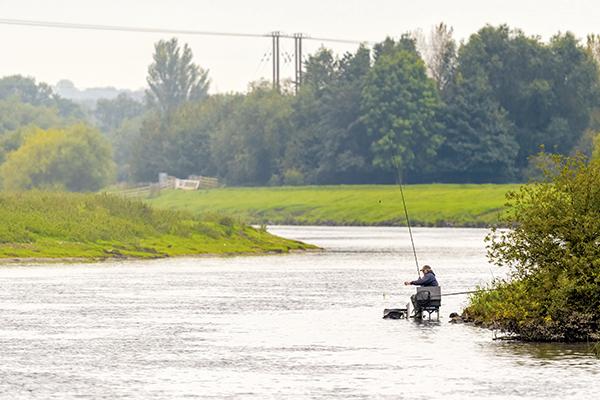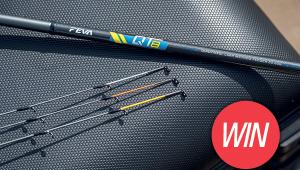Staying In Control

Way back in 1992 in Northern Ireland, on a stretch of the River Erne at Belleek in County Fermanagh, a new style of float fishing was being unveiled to anglers in the UK. It was the World Championship and it was held on a deep, fast flowing stretch of river and CIPS rules meant feeder fishing was banned. All the anglers from the Continent were fishing a method called the Bolognese or bolo, which involved the use of long, telescopic rods and big, heavy floats that looked more like giant traditional pole floats to us. With 20g or 30g of weight down the line, the Continentals were able to cast their rigs 30 metres and then hold all the line between the float and rod tip off the water and gently ease their floats down the swim thanks to a favourable upstream wind.
Anglers from the home nations were fishing sliders attached waggler style, which didn’t offer anywhere near the same levels of control. The results were dominated by teams fishing the Bolognese (except for some Aussie bloke who won the individual title on the slider), and before you knew it tackle catalogues in the UK had a new category filled with 6 and 7m telescopic rods. They never really took off in this country like they had done in mainland Europe though, and the reason for that became clear to anyone who fished with a very long bolo rod in the rain.
The UK is often wet and fishing a 6m rod that only has six or seven rings meant the line could sometimes stick to the wet blank so getting your float, and more importantly your hook bait, to travel down the swim in a way that was even semi-presentable to a fish, was pretty tricky. Before you knew it there were a lot of second-hand ‘only-used-once’ bolo rods on the market. Not to be defeated, the answer was a more traditional design of rod that was take-apart rather than telescopic, allowing rod designers to place those all-important guides along the blank to prevent the reel line from sticking. Problem solved. Combine these long rods with Bolognese style rigs (identical to heavy pole rigs) and anglers in the UK now have a great way of fishing further out with more control, or still maintain control in strong downstream winds by fishing closer in. And that brings me to Rob Perkins, who is no stranger to this style of fishing, and I caught up with him on the Caythorpe stretch of the River Trent, where he was presented with exactly that, a nasty downstreamer.
“This is as good as it gets at Caythorpe unfortunately,” commented Rob. “If the wind blows on this stretch it’s always a downstreamer! I was going to fish further upstream at Gunthorpe today but there’s only one small layby where you can park and it was full. The wind would have been more favourable there but not to worry, I’m still getting bites here on the bolo setup. It’s mainly small dace at the moment but I did put a tare on the hook a few minutes ago and had a nice roach on it straightaway, but I haven’t had a bite on it since! It’s early days though, so I might be able to catch a few more on it later on.
“They’ve just started running matches again along this stretch but unfortunately for me, I haven’t been able to get on one yet because of team fishing commitments with Hotrods. I think most of them are won with bream but when you’re not on them, or in a team event, you’ve got to catch these small dace and roach to do any good and there’s no better way than the long rod/bolo approach. There’s always the chance of some real quality roach too, as well as maybe a bonus chub but you don’t tend to see many of those here during the summer.”
Obviously the biggest hurdle to overcome when float fishing on a river in a downstream wind, is control. You can fish a waggler and get the line buried under the surface and out of the wind, but with good flow and depth close in there’s no need to fish too far out. With a long rod you can still achieve good presentation and that’s exactly what Rob was doing. The secret is to cast well downstream and I couldn’t believe how far down his swim his rig was landing. In a match with every peg in (which doesn’t happen any longer, anglers always have a spare peg either side these days), Rob couldn’t fish like this because I reckon his rig was landing almost in front of the swim downstream, maybe a couple of metres short of it. But with a spare peg downstream he still had plenty of water he could run the float down before he would be encroaching on the angler two pegs down (hypothetically).
So with a long rod and plenty of room, you can cast down the swim and the result of that is you can keep the line behind the float and stay in control. By feeding a good pouch of bait every run through, either hemp or maggots, Rob was managing to get bites and a fish pretty much every cast. “There’s a lot of small dace in the swim at the moment,” commented Rob. “In fact, I’ve never seen so many dace in the river as there are this year. They’re even having a tare when I put one on the hook. The better quality fish aren’t feeding at the moment but I have noticed the river has come up an inch since I started fishing, and on this stretch the fish don’t like a rising river. It’s a bit odd really because on the other bank at East Bridgford, they love it when there’s extra water coming in. I can’t explain that one! “I love these sort of days though, because I’ve got to work at it. I’ll get a couple of dumpy roach after I’ve changed something and then I’m back to catching dace. If I change something again I manage to get another couple of roach before the dace come back. Switching hook baits from double maggot to tare, and then to triple maggot, double red, double bronze – every change seems to result in a roach or two straightaway.”
The rod Rob is using is interesting because it’s actually a model that has been designed for fishing a running line down the edge on commercials! It’s a Middy Animal Tamer and he was using it at its 17ft length. This rod can also be fished at lengths of 15 and 20 feet with the right extension piece in place. “It’s not designed for river fishing, but it’s got a lovely tippy action, which is perfect for smaller fish and it picks line up quickly on the strike.” With around seven feet of water on the line he’s fishing, which we reckoned was equivalent to fishing 13 metres on the pole, Rob had opted for a 4g float. “I do fish these floats as light as 3g,” said Rob. “I’ve got the Maver Signature Finesse floats in 3g and 4g, and the Signature In-Line pattern in 5g and 6g sizes. They’re all stored on winders and I don’t think I need any floats larger than that for the type of fishing I do. The 4g float is perfect today with this depth and flow and if I fish any lighter than 3g, I prefer to use a big stick float on the long rod rather than a bolo float. I’ve got 12xNo4 stick floats in my box, which is equivalent to about 2.5g, as well as smaller sizes too. I prefer to fish the stick if I can, but it all depends on depth, flow and of course, the wind.”
Rob’s 4g rig consisted of a Maver Finesse float, which is an inline pattern with the reel line (4lb) running through the body, and then he had a 3.5g olivette just below half depth and this was anchored in place with a rubber float stop at either end and a couple of No10 shot below that. He had four No10 droppers but instead of a final dropper shot on the hooklength knot, he had a small quick-change swivel that was equal in weight to a No10. This not only prevented the hooklength from spinning up on the retrieve, it also allowed him to change it quickly if the need arose. His hooklength was 0.12mm to a size 16 Drennan Carbon Match, which is a micro-barb pattern.
As the session progressed Rob was having to feed more and more bait to try and feed the dace off and give him a fair chance of getting through to the roach, which were definitely in the swim. But, even with a selective tare on the hook, dace were a problem, as was a pike that showed itself a couple of times when Rob hooked a better roach. As I walked along the bank to take some pictures, I could see him refilling his maggot and hemp tubs with more bait as he began to pile it in. Eventually you could see the dace boiling on the surface every time he fed a pouch of bait and with them congregating up in the water, it gave him more of a chance to get his bait through them and down to the roach underneath.
“I’ve moved my olivette down a few inches so the rig is a bit more positive, and I’m definitely catching more roach now I’ve increased the feed,” said Rob. “I even tried feeding balls of groundbait earlier but that didn’t really do anything, so I stopped doing that and upped the feed instead. I had a good run of roach on the tare but then it died, so I changed back to maggot and had a couple of small dace followed by a better roach! Just when you think you’ve got it sorted, it dies and I have to do something else to try and catch roach again. I’ve even had a run of fish by casting further downstream away from where the feed is going in, which is where most of the dace seem to be.”
One thing was very clear though, without the extra control provided by the long rod, good bait presentation would have been very difficult. In Rob’s capable hands it looked easy, but it does take a bit of practice to get used to this style fishing. Would the pole have worked on the day and been better than the long rod/bolo approach? I don’t think it would because at 13 metres it would have been difficult to fish in the strong wind, and with a long line required so he could cover more of the swim I think Rob would have missed a lot of bites, because he would have been trying to strike against the wind. If you’ve got matches coming up on flowing water like here on the River Trent, you might regret it if you don’t have a long 17 to 20ft rod in your holdall.
- Log in or register to post comments












